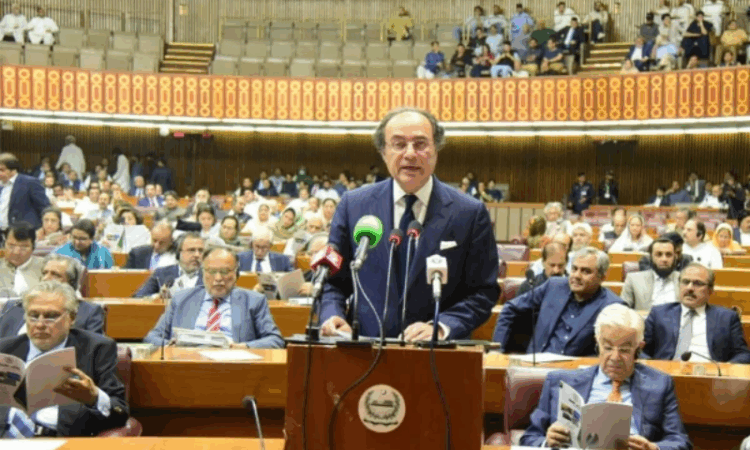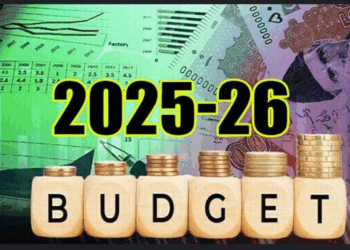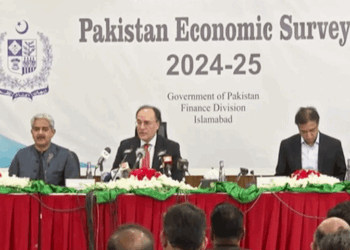Islamabad, June 10, 2025: The federal government of Pakistan on Tuesday unveiled its budget for the fiscal year 2025–26, totaling Rs17.6 trillion, amid strong protests and chants from opposition lawmakers in the National Assembly.
Federal Finance Minister Senator Muhammad Aurangzeb presented the budget, with Prime Minister Shehbaz Sharif in attendance. The opposition vocally rejected the proposals, accusing the government of ignoring public concerns.
Aurangzeb began his speech by referring to the budget as a “historic and pivotal” moment for the country. He hailed national unity demonstrated during the recent conflict with India and congratulated both the military and political leadership on Pakistan’s “success” in the war, claiming that the country’s global standing had improved as a result.
Major reforms in power sector underway
Aurangzeb stressed the need for deep and structural reforms in the power sector, which had already resulted in a reduction of billions in losses. He noted that the privatization of electricity companies in Faisalabad, Gujranwala, and Islamabad had been completed.
He further informed that the National Transmission and Dispatch Company (NTDC) had been divided into three separate entities and that professionals of international standards would be appointed in these institutions.
“We have formed non-political boards, which have helped reduce expenses and losses by Rs 140 billion,” he said, adding that the process for establishing a competitive energy market would begin within the next three months.
The federal government on Tuesday presented the budget for fiscal year 2025–26 in Parliament, proposing a total outlay of Rs17.573 trillion with a projected budget deficit of Rs6.501 trillion, amounting to 5% of GDP.
Economic outlook and stability
Highlighting recent economic gains, the finance minister said that reforms had restored economic stability, inflation had declined significantly, and remittances reached $36 billion over the past 10 months. “With national resolve and unity, we now shift our focus from survival to sustainable economic development,” he said.
Defence spending sees 20% hike
In the wake of May’s military escalation with India, Pakistan increased its defence allocation by 20%, setting it at Rs2,550 billion for FY2025–26, compared to Rs2,122 billion in the outgoing year. This continues a trend of rising military expenditure in recent years:
- FY2024–25: Rs2,122 billion (18% increase)
- FY2023–24: Rs1,804 billion (15% increase)
- FY2022–23: Rs1,563 billion (14% increase)
- FY2021–22: Rs1,370 billion (6% increase)
Corporate and real estate tax relief
The budget introduces several tax incentives aimed at stimulating business and property markets:
- Super tax on companies earning between Rs200–500 million reduced by 0.5%.
- Withholding tax on property purchases cut from 4% to 2.5% for the first slab; other slabs also reduced.
- 7% federal excise duty on commercial property transfers abolished.
- Tax credit introduced for houses up to 10 marlas and flats up to 2,000 sq ft.
- Stamp duty in Islamabad reduced from 4% to 1%.
These measures are intended to encourage homeownership and invigorate real estate investment.
Major pension reforms announced
The government introduced structural reforms to the pension system to reduce fiscal pressure:
- Family pensions limited to 10 years after the pensioner’s death.
- Pension increases linked to the Consumer Price Index.
- Early retirements discouraged.
- Rehiring of retired officials restricted to either a pension or salary—not both.
Experts have welcomed the move as a step toward long-term fiscal sustainability.
Carbon levy introduced on fuels
A new carbon levy on petroleum products was announced to raise revenue and promote environmental responsibility:
- Rs2.5/litre in FY2025–26 on motor spirit and diesel (expected revenue: Rs48 billion).
- Rate to double to Rs5/litre in FY2026–27 (projected revenue: Rs96 billion).
- Rs2/litre levy on furnace oil to be increased to Rs5/litre next year.
The Petroleum Levy Ordinance 1961 will be amended to incorporate the new levy.
Budget 2025–26 highlights
Macroeconomic Targets:
- GDP Growth: 3.9%
- Inflation: 12.3%
- Fiscal Deficit: 5.5% of GDP
- Tax-to-GDP Ratio: Targeted at 10% (currently 8.8%)
Key Budget Measures and Sectoral Allocations
FBR reforms:
- AI-based audits and digital tracking systems
- Broadened tax base and tougher non-filer penalties
Energy Sector:
- Rs389 billion to reduce circular debt
- Tariff rationalization and solar/wind energy promotion
Privatization:
- Accelerated plans for PIA, DISCOs, and non-essential SOEs
Agriculture:
- Rs178 billion for “Green Pakistan Initiative”
- Climate-smart farming and digital subsidy disbursements
Social Protection:
- BISP coverage increased by 15%, focusing on women
- Pensions indexed to inflation
- Financial literacy and support for vulnerable groups
IT & Digitalization:
- Target of $25 billion in IT exports by 2029
- E-governance platforms for public services
- Digital Services Tax on foreign e-commerce platforms
Water & Climate:
- Rs69 billion for dams and irrigation (e.g., K-IV project)
- Rs16 billion for climate adaptation (flood control, water conservation)
Healthcare & Education:
- Rs21 billion for preventive healthcare; upgrades for 90 hospitals
- 18.5% increase in education budget; focus on skills and early childhood education
SMEs & Housing:
- Rs47 billion for SME credit access
- Subsidized mortgage schemes for low-income families
Overseas Pakistanis:
- Targeting $31.3 billion in remittances
- Simplified banking channels and skill development programs
Governance & Judicial Reforms:
- 10% reduction in non-essential federal posts
- Fast-track courts for tax-related disputes
Major Budgetary Allocations (PKR Billion)
- Health: 21
- Education: 18.5
- BISP: 592
- Climate: 16
- Energy Circular Debt: 389
- Agriculture: 178
Challenges Addressed
- Curbing inflation (12.3% target)
- Energy inefficiencies and circular debt
- Expanding the tax net
- Climate resilience and disaster preparedness
The FY2025–26 budget underscores fiscal consolidation, economic growth, and social equity, with an emphasis on digitization, privatization, and climate resilience. However, successful implementation will be crucial amid ongoing political opposition and external economic pressures.








